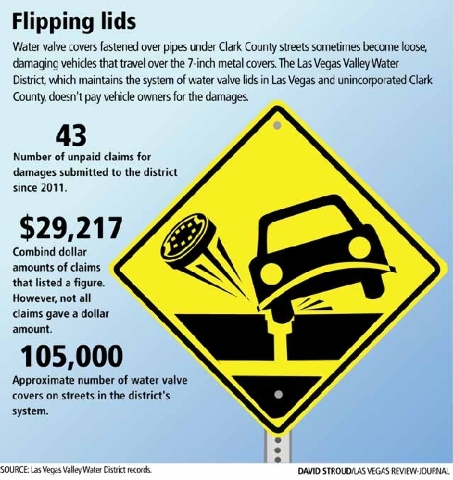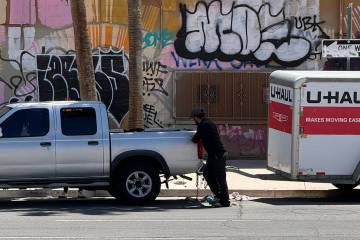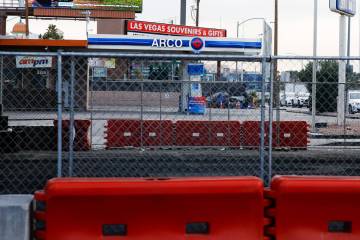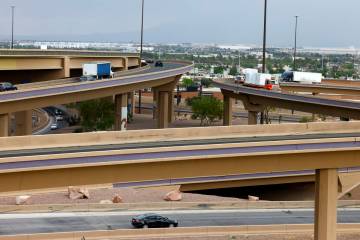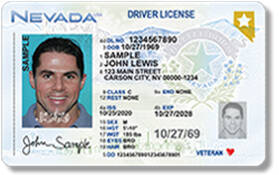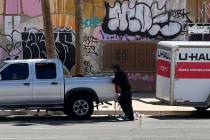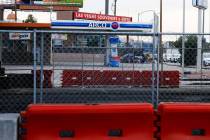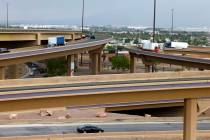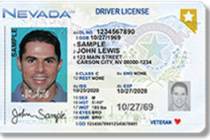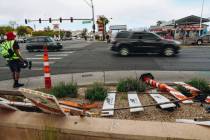Local governments say road damage to cars is not their problem
Peter Dixon was driving his car north on South Jones Boulevard just past Alta Drive when he hit a loose water valve cover.
The 7-inch metal discs that rest atop water valves usually are level with the street.
Not this one.
When a tire on Dixon’s 1999 Mercury Sable hit the valve cover, the disc flipped up under his car, damaging the motor, transmission assembly and an engine seal.
His car skidded and slid around, and he finally cut the ignition to stop it before losing control entirely.
After the June 27 incident, Dixon filed a claim with the Las Vegas Valley Water District, which maintains the valve covers. In his claim, Dixon included photos of his damaged vehicle, the loose cover, an accident report and a mechanic’s repair estimate.
But the district hasn’t coughed up any dough for Dixon’s troubles. And he’s not alone.
Since 2011, 43 motorists have unsuccessfully filed claims with the water district for damages to vehicles because of hitting loose valve lids or the holes they cover, public records show.
Dixon is left with a car that won’t run and a repair bill of more than $5,000 he can’t afford. He is making do by borrowing vehicles from friends, but he’s also missing work without reliable transportation.
“It’s hard,” said Dixon, of Las Vegas. “It’s very disgusting to know you have a vehicle and you can’t drive it. Right now, I’m just at a hardship.”
The district’s handling of Dixon’s case falls in line with how it handles other hazard claims.
Citing a Nevada state law in place since 1965, the district contends it’s not legally responsible for the loose cover because it didn’t know about the hazard beforehand. That law covers the liability of government agencies — and the exceptions for when they are not responsible. One of those exceptions is hazardous conditions in which the district had no prior knowledge.
In a July 3 letter to Dixon, deputy counsel Mary E. Madden wrote that the district “thoroughly investigated” the location and determined it had no prior knowledge of a dislodged valve lid.
“Immediately after receiving your call, the District responded to the location and took the necessary action with respect to the valve lid,” Madden wrote to Dixon on July 3.
Whenever it gets a claim, the district checks its maintenance records to see if any workers were recently at the location and may have left the lid loose, said Bronson Mack, a spokesman for the district. If there is a possibility of neglect, the district will make it right, he said, stressing the district has procedures to keep that from happening.
Mack defended the law, saying it is necessary to avoid frivolous claims. For example, someone could remove the cover and then file a claim for new wheels and rims, he said.
“Without these kinds of laws, we could have a situation that could be rife with abuse,” Mack said.
The metal covers, weighing 12 pounds or 24 pounds, aren’t bolted down. Each cover has three-pronged fins extending below for about 7½ inches, which are intended to keep it flush with the street.
There are different theories about how the valve covers can come loose, such as a contractor checking the line or a vandal with malicious intent, Mack said.
Another theory is that if a vehicle hits the cover at just the right speed and angle, it’s enough to loosen them, he said.
Regardless of the circumstances, the district will respond and fix any situations with loose covers, Mack said.
He also pointed to the low odds of motorists hitting a loose valve cover, given the 43 claims compared to roughly 105,000 lids on the streets of unincorporated Clark County and Las Vegas. That’s too many to make daily checks, he said, but employees such as meter readers keep an eye out for loose or missing lids, and the district will respond quickly to public complaints about the same.
In New York City, officials once had help looking for defects, courtesy of lawyers looking for a way to skirt a similar law passed by the city in 1979.
The New York State Trial Lawers’ Association formed the Big Apple Pothole and Sidewalk Protection Committee, according a Jan. 6, 2008, article in The New York Times.
The lawyers hired a mapping company to document street and sidewalk defects and report them so that the required notice would be on file, according to the newspaper.
The mapping effort ended in 2005, after a new city law made most property owners adjacent to sidewalks responsible for injuries from sidewalk defects instead of the city, according to the newspaper.
There is no comparable effort in Las Vegas.
OTHER CLAIMS
A Review-Journal analysis of the claim records showed a variety of circumstances for the unlucky motorists. The locations varied, from near the intersection of Las Vegas Boulevard and Warm Springs Road to the 5100 block of West Lone Mountain Road.
The vehicles were diverse, too, from a sporty Corvette to a pickup.
For those who had third-party representation, such as an attorney or insurance carrier, the results were the same: a denial.
Not all the claims listed a dollar amount. For those that did, the combined figure was $29,217, the bulk of it for vehicle damages to tires and rims. Other damages included busted oil pans and repairs for leaking fluids.
Renee Kunze of Las Vegas hit a valve cover July 4 with her 2013 Volkswagen Jetta while traveling north on Bermuda Road near Serene Avenue. After insurance paid part of the repair bill, the unemployed Kunze is left with a $500 bill she can’t afford.
“It was horrible,” she said. “I think it’s ridiculous. It’s not the same as hitting a pothole. It’s a water valve that’s not properly installed.”
Ann Bradley of Las Vegas was driving her car on June 27 along Vegas Drive east of Jones Boulevard.
“It was really scary,” she said. “I hit this really hard thing and my car started wobbling. I got out and realized I had a flat tire. Then I realized I had two flat tires.”
Like the others, she filed a claim for $1,100 for two tires and two rims.
“Then I got a nice little letter from them saying they were not aware of it and they’re not responsible,” she said.
Bradley, like Dixon, said the law is a loophole.
In Dixon’s view, the law doesn’t work because a driver isn’t going to usually see a loose cover until after running over it — and getting the damage that accompanies it.
“They say they’re trying to protect the taxpayer,” Dixon said. “They’re not protecting the taxpayer. They’re not protecting me.”
Contact reporter Ben Botkin at
bbotkin@reviewjournal.com or 702-405-9781.
Follow him on Twitter @BenBotkin1.
Flipping lids
Water valve covers fastened over pipes under Clark County streets sometimes become loose, damaging vehicles that travel over the 7-inch metal covers. The Las Vegas Valley Water District, which maintains the system of water valve lids in Las Vegas and unincorporated Clark county, doesn’t pay vehicle owners for the damages.
43 — Number of unpaid claims for damages submitted to the district since 2011.
$29,217 — Combined dollar amounts of claims that listed a figure. However, not all claims gave a dollar amount.
105,000 — Approximate number of water valve covers on streets in the district’s system.



